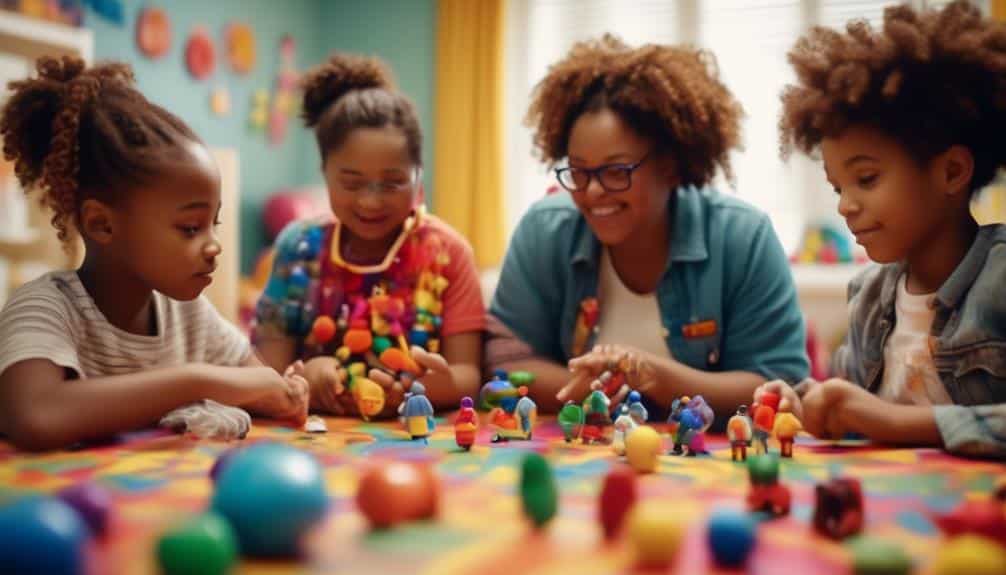In recent years, the approach known as DIRFloortime building bridges has gained traction as an effective intervention for children with Autism Spectrum Disorder (ASD). This method, rooted in the Developmental Individual-difference Relationship-based model, focuses on understanding each child’s unique traits to foster social, emotional, and cognitive development. Professionals endorse DIRFloortime building bridges for its tailored approach, which aims to bridge the gap between a child’s individual differences and developmental needs.
Its emphasis on nurturing relationships is also seen as a fundamental therapy component. As we assess the effectiveness of DIRFloortime building bridges in therapy, it’s crucial to understand what sets it apart from other interventions and how it equips practitioners and families with tools to facilitate a child’s development.
Key Takeaways
- DIRFloortime is a relationship-based therapy for autistic children that integrates developmental theory and individualized understanding of each child’s profile.
- The therapy focuses on social, emotional, and cognitive capacities, prioritizing foundational communication skills and fostering emotional and mental growth.
- DIRFloortime harnesses children’s natural curiosities and affinities, creating a therapeutic environment that prioritizes their interests.
- Empirical support and research findings consistently validate the efficacy of DIRFloortime, showing improvements in communication, emotional regulation, social interaction, and secure attachment behaviors.
Understanding DIRFloortime
DIRFloortime is an innovative and empathetic relationship-based therapy that actively engages children with autism in interactive play to foster their developmental milestones and enhance communication skills. As a cornerstone of the Developmental Individual-difference Relationship-based model or DIR, this approach targets the unique developmental level of each autistic child, tailoring interventions to their specific needs and capacities. Central to DIRFloortime is the concept DIR/Floortime, which emphasizes the importance of play therapy in an early intervention program and creates an emotionally supportive environment where children with Autism Spectrum Disorders can explore and learn.
Ttherapy’sy’s foundational aim is to cultivate children’s communication and adaptive abilities by nurturing their social and emotional development. Practitioners, including a spectrum of specialists from child psychologists to parents, are trained to engage in this specialized play therapy, which can span two to five hours daily. These interactions are designed to open and expand circles of communication, mirroring the natural ebb and flow of human connection, which can be particularly challenging for children experiencing developmental delays.
DIRFloortime supports the child’s growth and equips caregivers with the tools to foster these essential skills, ensuring a collaborative and informed approach to nurturing the child’s development.
Core Objectives and Milestones

Central to the success of the Developmental Individual-difference Relationship-based (DIR) model is its ability to address and promote crucial developmental milestones through engaging in play-based interactions tailored explicitly to facilitate children’s emotional, cognitive, and communicative growth. Proponents of DIR/Floortime, such as Stanley Greenspan, emphasize the importance of nurturing foundational communication skills and opening and closing circles of communication, which are vital for autistic children.
DIR/Floortime techniques prioritize emotional and developmental progress, focusing on the dynamics of parent-child interactions. This empathetic and analytical approach to autism spectrum disorders ensures that each child’s unique developmental trajectory is honored and fostered.
| Developmental Milestones | Objectives of DIRFloortime | Impact on Autistic Children |
|---|---|---|
| Self-regulation | Enhance sensory processing | Fosters a sense of security |
| Intimacy and Relationships | Facilitate engagement | Develops trust and bonding |
| Two-way Communication | Promote mutual communication skills | Encourages interaction |
| Complex Communication | Foster emotional and cognitive growth | Enhances understanding |
| Logical and Reflective Thinking | Support symbolic thought | Inspires creativity and logic |
DIR/Floortime adeptly guides each child toward reaching and surpassing their potential through personalized and developmentally attuned interventions.
Implementing Key Strategies

To effectively apply the DIRFloortime approach, practitioners must first grasp its foundational principles, which hinge on harnessing children’s natural curiosities and affinities to foster meaningful interactions and communication skills. The Floortime program is crafted to establish a therapeutic environment where children’s interests take center stage, promoting a more natural and captivating therapy experience tailored for those with Autism Spectrum Disorder (ASD).
Daily Floortime sessions aim to establish a rhythm of parent-child interaction that is comforting and conducive to learning. By maintaining a calm and inclusive environment, children with autism are more likely to feel secure, allowing them to open up and explore their surroundings. Therapists and parents alike are trained to identify and follow the child’s lead, reinforcing their initiative and desire to connect, which is central to the developmental approach of the Floortime model.
The emotional connection fostered through these interactions is pivotal, as it helps build the foundation for opening and closing circles of communication. This back-and-forth play is about exchanging words or actions and nurturing a dynamic relationship that can evolve. Integrating parents in this process is crucial, as consistently reinforcing these strategies at home solidifies the gains made during therapy sessions.
Evidence and Research Findings

The empirical support for Dirfloortime techniques in autism intervention is robust, highlighting its versatility and efficacy across various developmental domains. As reported in multiple studies, clinical outcomes suggest that Floortime therapy can substantially improve communication, emotional regulation, and social interaction. This evidence underscores the potential of Floortime as a compassionate and effective modality for fostering developmental gains in children with Autism Spectrum Disorder (ASD).
Research-Backed Effectiveness
Numerous studies have validated the efficacy of Dirfloortime techniques, demonstrating marked improvements in the socio-emotional and communicative development of children with Autism Spectrum Disorder (ASD).
- Systematic Review Outcomes: Evidence-based research studies have consistently shown that Floortime is a potent therapeutic intervention for enhancing communication skills and emotional growth in autistic children.
- Home-Based Advantages: Implementing Floortime in familiar environments has led to notable progress in daily living skills and parent-child interaction quality, contributing to a more supportive developmental journey.
- DIR/Floor Time in Engaging Autistic Children: The approach has been instrumental in fostering secure attachment behaviors, thereby unlocking new avenues for socio-emotional engagement and symptom alleviatioFloortime’se’s research-backed effectiveness provides a compelling case for its integration into autism care strategies, resonating with those committed to nurturing the developmental pathways of children on the spectrum.
Clinical Outcome Improvements
How does Floortime influence clinical outcomes for children with Autism Spectrum Disorder? Research indicates a significant enhancement in various developmental domains when this intervention is applied. Unlike traditional applied behavior analysis, Floortime focuses on following autistic children’s interests to improve their emotional functioning and developmental skills. Clinical outcome improvements are notable as parents and therapists interact with the child within this empathetic framework.
Studies have shown that home-based Floortime particularly bolsters communication, emotional expression, and daily living skills. Mothers report more meaningful interactions with their children during Floortime sessions, underpinning the importance of this method. Significantly, no adverse events were associated with Floortime, highlighting its safety and positive impact on children with autism and their families.
Navigating Challenges and Misconceptions

Understanding the distinctions between Floortime and traditional Applied Behavior Analysis (ABA) therapy is essential for parents and professionals navigating the diverse landscape of autism interventions. Floortime emphasizes developmental and learning processes tailored to each child’s differences, while ABA often focuses on modifying behaviors through reinforcement strategies.
When considering therapy for autistic children, navigating challenges and misconceptions about Floortime can be daunting. To help autistic children and their families, it is essential to:
- Debunk myths that Floortime is less structured or effective than ABA by highlighting its evidence-based, child-centered approach.
- Empower parents with training and resources to implement Floortime techniques at home, fostering a collaborative environment for development.
- Advocate for including Floortime in special needs programs, emphasizing its benefits alongside other behavioral therapies as part of a comprehensive intervention strategy.
An informed and analytical perspective is necessary to understand how Floortime can help autistic children engage with the world around them. By empathetically addressing individual needs and remaining open to a combination of therapeutic approaches, we can ensure that each child receives the support they require to thrive.
Accessing Qualified DIRFloortime Providers

While navigating challenges and misconceptions is a crucial step, securing services from qualified DIRFloortime providers is equally important for ensuring adequate support for autistic children. The DIRFloortime therapy, developed by Dr. Stanley Greenspan and Dr. Serena Wieder, emphasizes emotional and relational development as critical to the growth of autistic children. To engage effectively in this treatment modality, one must seek providers like child psychologists, special education teachers, speech therapists, and occupational therapists who are well-versed in the developmental approach.
Professionals certified by the Interdisciplinary Council on Development and Learning (ICDL) ensure a standard of expertise in the DIRFloortime framework, which is indispensable for tailoring interventions to autistic people’s unique profiles. Additionally, directories and organizations dedicated to connecting families with qualified DIRFloortime providers are invaluable resources for finding the right match for a child’s developmental needs.
Parent and caregiver education are also pivotal elements of the therapy process. Certified professionals offer training programs that empower caregivers to implement Floortime strategies, fostering an environment conducive to the child’s developmental progress. By accessing these resources, including workshops, books, and websites, stakeholders can enrich their understanding and application of DIRFloortime techniques, ensuring a comprehensive, empathetic, and practical approach to ASD treatment.
Frequently Asked Questions
How has DIRFloortime Building Bridges Been so Effective in Autism Therapy?
DIR Floortime promotes emotional and intellectual growth, enabling children to build stronger foundations for social, emotional, and cognitive skills through interactive play that meets them at their developmental level and respects their unique rhythms.
How Effective Is Floortime for Autism?
Floortime has proven effective for autism, fostering significant developmental progress. Its emphasis on emotional connections and individual interests aligns with compassionate care, resonating with those committed to enhancing autistic children’s communication and relational abilities.
Which Intervention for Autism Is Considered Most Effective?
The most effective intervention for autism varies depending on individual needs, with options like ABA, speech therapy, and occupational therapy often recommended. Interdisciplinary approaches tailored to the child typically yield the best outcomes.
What Are the Benefits of Floortime?
Floortime offers numerous advantages for developmental progress, including sensory, motor, and communication skill enhancement. It fosters emotional growth and reciprocal communication, enabling children to interpret sensory experiences better and form secure, responsive relationships.
Conclusion
DIRFloortime, developed by Stanley Greenspan, is a comprehensive approach to therapy for children with autism spectrum disorders. It focuses on fostering meaningful connections and supporting individual differences in development. The model emphasizes the importance of emotional connections and social engagement through playful interactions and reciprocal communication styles. It has been proven effective in supporting various developmental capacities, including cognitive, social, and emotional growth.
In a pilot study published in the Journal of Developmental and Learning Disorders, DIRFloortime effectively supported the development of cognitive skills, social skills, and emotional well-being in children with autism. The model promotes a holistic and individualized approach, recognizing each child’s unique interaction styles and developmental delays. DIRFloortime bridges the gap between therapy and real-life experiences, promoting adaptive behavior and functional development by providing a supportive environment for play-based interactions and meaningful engagement.
The DIRFloortime model also emphasizes the importance of parent engagement and training, recognizing the power of relationships in supporting a child’s development. By focusing on social-communication-based interventions and playful learning activities, DIRFloortime offers a safe and nurturing environment for children with autism to grow and thrive.


Recent Comments